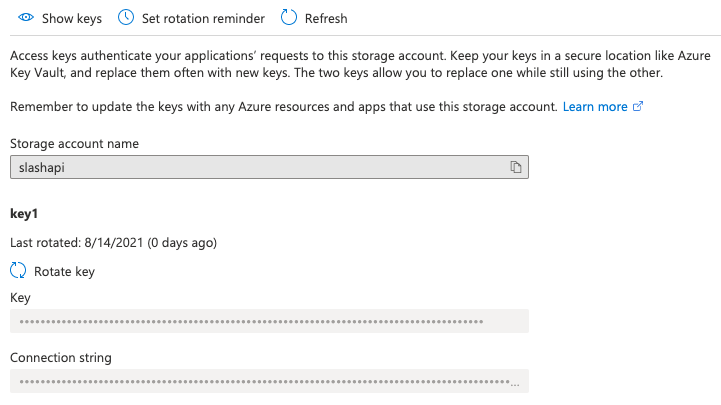Connect with Azure Blob Storage without any backend coding.
Azure Blob storage is Microsoft's object storage solution for the cloud. It allows users to store large amounts of unstructured data on Microsoft’s data storage platform. In this case, Blob stands for Binary Large Object, which includes objects such as images and multimedia files. These are known as unstructured data because they don’t follow any particular data model.
Users or client applications can access objects in Blob storage via HTTP/HTTPS, from anywhere in the world. Objects in Blob storage are accessible via the REST API. Therefore, SlashApi provide a simple API endpoint to connect with your Azure Blob Storage data using API without writing any backend code.
After you create an account and log in to the dashboard, choose Azure Blob Storage on the collections page. To make Azure Blob Storage API we need these values:
To get the connection string, you need to login to your azure portal.
After login to your portal, choose Storage accounts.
Choose Access keys under the Security + Networking section from the left sidebar
You will find your connection string on the Access keys page.

You can get your container name on your Azure Storage accounts. On the left sidebar choose Containers menu under the Data storage section.

List all files in your Azure Blob Storage
| Parameter | Description |
|---|---|
| recursive | Operating on a directory and its contents, including the contents of any subdirectories |
| directory | Directory root |
var axios = require('axios');
var config = {
method: 'get',
url: 'http://v1.slashapi.com/slashapi/azure/u2nyrJqa0f/files?directory=your-directory'
};
axios(config)
.then(function (response) {
console.log(JSON.stringify(response.data));
})
.catch(function (error) {
console.log(error);
});
List all directories in your Azure Blob Storage
| Parameter | Description |
|---|---|
| recursive | Operating on a directory and its contents, including the contents of any subdirectories |
| directory | Directory root |
var axios = require('axios');
var config = {
method: 'get',
url: 'http://v1.slashapi.com/slashapi/azure/u2nyrJqa0f/directories?directory=your-directory'
};
axios(config)
.then(function (response) {
console.log(JSON.stringify(response.data));
})
.catch(function (error) {
console.log(error);
});
Download File from your Azure Blob Storage
| Parameter | Description |
|---|---|
| path | [required] Path to file |
var axios = require('axios');
var config = {
method: 'get',
url: 'http://v1.slashapi.com/slashapi/azure/u2nyrJqa0f/download?path=path-to-file'
};
axios(config)
.then(function (response) {
console.log(JSON.stringify(response.data));
})
.catch(function (error) {
console.log(error);
});
Upload File to your Azure Blob Storage.
| Body | Description |
|---|---|
| file | [required] File to upload |
| directory | Destination directory for your uploaded file |
var axios = require('axios');
var FormData = require('form-data');
var fs = require('fs');
var data = new FormData();
data.append('file', fs.createReadStream('/path/to/file'));
data.append('directory', 'target-directory');
var config = {
method: 'post',
url: 'http://v1.slashapi.com/slashapi/azure/u2nyrJqa0f',
headers: {
...data.getHeaders()
},
data : data
};
axios(config)
.then(function (response) {
console.log(JSON.stringify(response.data));
})
.catch(function (error) {
console.log(error);
});
Delete Files in your Azure Blob Storage
| Body | Description |
|---|---|
| files | [required] Path to files. To delete multiple files, you can pass an array |
var axios = require('axios');
var data = JSON.stringify({
"files": [
"Directory/your-file.jpeg"
]
});
var config = {
method: 'delete',
url: 'http://v1.slashapi.com/slashapi/azure/u2nyrJqa0f',
headers: {
'Content-Type': 'application/json'
},
data : data
};
axios(config)
.then(function (response) {
console.log(JSON.stringify(response.data));
})
.catch(function (error) {
console.log(error);
});
Delete directory in your Azure Blob Storage
| Body | Description |
|---|---|
| directory | [required] Target directory |
var axios = require('axios');
var data = JSON.stringify({
"directory": "target-directory"
});
var config = {
method: 'delete',
url: 'http://v1.slashapi.com/slashapi/azure/u2nyrJqa0f',
headers: {
'Content-Type': 'application/json'
},
data : data
};
axios(config)
.then(function (response) {
console.log(JSON.stringify(response.data));
})
.catch(function (error) {
console.log(error);
});